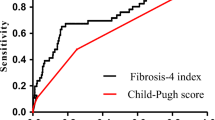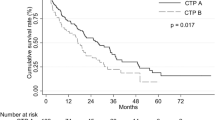Abstract
Purpose
We evaluated the prognosis of hepatocellular carcinoma (HCC) patients with Child-Pugh (C-P) class A based on FIB-4 index, which is a liver fibrosis marker.
Patients and methods
A total of 915 HCC patients with C-P class A were investigated. We assessed the prognosis using FIB-4 index, and factors associated with survival rates were analyzed in these patients.
Results
When patients were categorized according to FIB-4 index as <2.0 (n = 93), ≥2.0 and <4.0 (n = 311), and ≥4.0 (n = 511), survival rates at 5 years were 70.5 % [95 % confidence interval (CI) 59.0–79.9], 56.4 % (95 % CI 50.1–62.5), and 47.1 % (95 % CI 42.2–52.1), respectively. Patients with FIB-4 index <2.0 had a higher survival rate than the other groups (≥4.0 vs ≥2.0 and <4.0, p = 0.010; ≥2.0 and <4.0 vs <2.0, p = 0.028). We were able to predict prognosis in patients with C-P score 5 by FIB-4 index, but survival rate did not significantly differ in patients with C-P score 6. Multivariate analysis identified C-P score, FIB-4 index [≥2.0 and <4.0; hazard ratios (HRs) 1.638 (95 % CI 1.084–2.474); p = 0.019/≥4.0; HR 1.828 (95 % CI 1.217–2.744); p = 0.004], Lens culinaris agglutinin-reactive α-fetoprotein, tumor size, number, vascular invasion, antiviral therapy, and hepatectomy as independent predictive factors for survival.
Conclusions
The FIB-4 index is useful for assessing prognosis in HCC patients with C-P class A, especially those with C-P score 5.





Similar content being viewed by others
Abbreviations
- HCC:
-
Hepatocellular carcinoma
- C-P:
-
Child-Pugh
- SVR:
-
Sustained virological response
- HCV:
-
Hepatitis C virus
- HBV:
-
Hepatitis B virus
- EASL:
-
European Association for the Study of the Liver
- AFP:
-
α-Fetoprotein
- AFP-L3:
-
Lens culinaris agglutinin-reactive α-fetoprotein
- DCP:
-
Des-γ-carboxy prothrombin
- US:
-
Ultrasonography
- CT:
-
Computed tomography
- MRI:
-
Magnetic resonance imaging
- AST:
-
Aspartate aminotransferase
- ALT:
-
Alanine aminotransferase
- HR:
-
Hazard ratio
- LAT:
-
Locoregional ablative therapy
- RFA:
-
Radiofrequency ablation
- TACE:
-
Transcatheter arterial chemoembolization
- CI:
-
Confidence interval
References
A new prognostic system for hepatocellular carcinoma (1998) A retrospective study of 435 patients: the Cancer of the Liver Italian Program (CLIP) investigators. Hepatology 28:751–755
Afdhal N, Zeuzem S, Kwo P, Chojkier M, Gitlin N, Puoti M et al (2014a) The ION-1 investigators. Ledipasvir and sofosbuvir for untreated HCV genotype 1 infection. N Engl J Med 370:1889–1898
Afdhal N, Reddy KR, Nelson DR, Lawitz E, Gordon SC, Schiff E et al (2014b) Ledipasvir and sofosbuvir for previously treated HCV genotype 1 infection. ION-2 investigators. N Engl J Med 370:1483–1493
Buster EH, Hansen BE, Buti M, Delwaide J, Niederau C, Michielsen PP et al (2007) HBV 99-01 Study Group. Peginterferon alpha-2b is safe and effective in HBeAg-positive chronic hepatitis B patients with advanced fibrosis. Hepatology 46:388–394
Clinical Practice Guidelines for Hepatocellular Carcinoma (2009) The Japan Society of Hepatology update. Hepatol Res 2010(40):2–144
de Lope CR, Tremosini S, Forner A, Reig M, Bruix J (2012) Management of HCC. J Hepatol 56:75–87
El-Serag HB, Rudolph KL (2007) Hepatocellular carcinoma: epidemiology and molecular carcinogenesis. Gastroenterology 132:2557–2576
European Association for the Study of the Liver (2012) European Organisation for Research and Treatment of Cancer. EASL-EORTC clinical practice guidelines: management of hepatocellular carcinoma. J Hepatol 56:908–943
Fernández-Esparrach G, Sánchez-Fueyo A, Ginès P, Uriz J, Quintó L, Ventura PJ et al (2001) A prognostic model for predicting survival in cirrhosis with ascites. J Hepatol 34:46–52
Izumi R, Shimizu K, Ii T, Yagi M, Matsui O, Nonomura A et al (1994) Prognostic factors of hepatocellular carcinoma in patients undergoing hepatic resection. Gastroenterology 106:720–727
Jacobson IM, Gordon SC, Kowdley KV, Yoshida EM, Rodriguez-Torres M, Sulkowski MS et al (2013) POSITRON Study; FUSION Study; Sofosbuvir for hepatitis C genotype 2 or 3 in patients without treatment options. N Engl J Med 368:1867–1877
Jemal A, Bray F, Center MM, Ferlay J, Ward E, Forman D (2011) Global cancer statistics. CA Cancer J Clin 61:69–90
Kudo M, Chung H, Haji S, Osaki Y, Oka H, Seki T et al (2004) Validation of a new prognostic staging system for hepatocellular carcinoma: the JIS score compared with the CLIP score. Hepatology 40:1396–1405
Kumada T, Toyoda H, Kiriyama S, Tanikawa M, Hisanaga Y, Kanamori A et al (2013a) Characteristics of elderly hepatitis C virus-associated hepatocellular carcinoma patients. J Gastroenterol Hepatol 28:357–364
Kumada T, Toyoda H, Tada T, Kiriyama S, Tanikawa M, Hisanaga Y et al (2013b) Effect of nucleos(t)ide analogue therapy on hepatocarcinogenesis in chronic hepatitis B patients: a propensity score analysis. J Hepatol 58:427–433
Leroy V, Hilleret MN, Sturm N, Trocme C, Renversez JC, Faure P et al (2007) Prospective comparison of six non-invasive scores for the diagnosis of liver fibrosis in chronic hepatitis C. J Hepatol 46:775–782
Llovet JM, Brú C, Bruix J (1999) Prognosis of hepatocellular carcinoma: the BCLC staging classification. Semin Liver Dis 19:329–338
Lok AS, Gardiner DF, Lawitz E, Martorell C, Everson GT, Ghalib R, Reindollar R, Rustgi V, McPhee F, Wind-Rotolo M, Persson A, Zhu K, Dimitrova DI, Eley T, Guo T, Grasela DM, Pasquinelli C et al (2012) Preliminary study of two antiviral agents for hepatitis C genotype 1. N Engl J Med 366:216–224
Merkel C, Bolognesi M, Sacerdoti D, Bombonato G, Bellini B, Bighin R et al (2000) The hemodynamic response to medical treatment of portal hypertension as a predictor of clinical effectiveness in the primary prophylaxis of variceal bleeding in cirrhosis. Hepatology 32:930–934
Pugh RN, Murray-Lyon IM, Dawson JL, Pietroni MC, Williams R (1973) Transection of the oesophagus for bleeding oesophageal varices. Br J Surg 60:646–649
Schiff E, Simsek H, Lee WM, Chao YC, Sette H Jr, Janssen HL et al (2008) Efficacy and safety of entecavir in patients with chronic hepatitis B and advanced hepatic fibrosis or cirrhosis. Am J Gastroenterol 103:2776–2783
Sebastiani G, Vario A, Guido M, Noventa F, Plebani M, Pistis R et al (2006) Stepwise combination algorithms of non-invasive markers to diagnose significant fibrosis in chronic hepatitis C. J Hepatol 44:686–693
Shah AG, Lydecker A, Murray K, Tetri BN, Contos MJ, Sanyal AJ (2009) Nash Clinical Research Network. Comparison of noninvasive markers of fibrosis in patients with nonalcoholic fatty liver disease. Clin Gastroenterol Hepatol 7:1104–1112
Shim JH, Lee HC, Kim KM, Lim YS, Chung YH, Lee YS et al (2010) Efficacy of entecavir in treatment-naïve patients with hepatitis B virus-related decompensated cirrhosis. J Hepatol 52:176–182
Sterling RK, Lissen E, Clumeck N, Sola R, Correa MC, Montaner J et al (2006) APRICOT Clinical Investigators. Development of a simple noninvasive index to predict significant fibrosis in patients with HIV/HCV coinfection. Hepatology 43:1317–1725
Tamaki N, Kurosaki M, Matsuda S, Muraoka M, Yasui Y, Suzuki S et al (2013) Non-invasive prediction of hepatocellular carcinoma development using serum fibrosis marker in chronic hepatitis C patients. J Gastroenterol. doi:10.1007/s00535-013-0914-y
Toyoda H, Kumada T, Tada T, Sone Y, Kaneoka Y, Maeda A (2011) Characteristics and prognosis of patients with hepatocellular carcinoma after the year 2000 in Japan. J Gastroenterol Hepatol 26:1765–1771
Umemura T, Ichijo T, Yoshizawa K, Tanaka E, Kiyosawa K (2009) Epidemiology of hepatocellular carcinoma in Japan. J Gastroenterol 44:102–107
Vallet-Pichard A, Mallet V, Nalpas B, Verkarre V, Nalpas A, Dhalluin-Venier V et al (2007) FIB-4: an inexpensive and accurate marker of fibrosis in HCV infection. Comparison with liver biopsy and fibrotest. Hepatology 46:32–36
Vergniol J, Boursier J, Coutzac C, Bertrais S, Foucher J, Angel C et al (2014) The evolution of non-invasive tests of liver fibrosis is associated with prognosis in patients with chronic hepatitis C. Hepatology 60:65–76
Wai CT, Greenson JK, Fontana RJ, Kalbfleisch JD, Marrero JA, Conjeevaram HS et al (2003) A simple noninvasive index can predict both significant fibrosis and cirrhosis in patients with chronic heparins C. Hepatology 38:518–526
Acknowledgments
There is no grant or other financial support for this study.
Conflict of interest
The authors declare no conflicts of interests.
Author information
Authors and Affiliations
Corresponding author
Rights and permissions
About this article
Cite this article
Ito, T., Kumada, T., Toyoda, H. et al. FIB-4 index for assessing the prognosis of hepatocellular carcinoma in patients with Child-Pugh class A liver function. J Cancer Res Clin Oncol 141, 1311–1319 (2015). https://doi.org/10.1007/s00432-015-1922-5
Received:
Accepted:
Published:
Issue Date:
DOI: https://doi.org/10.1007/s00432-015-1922-5




